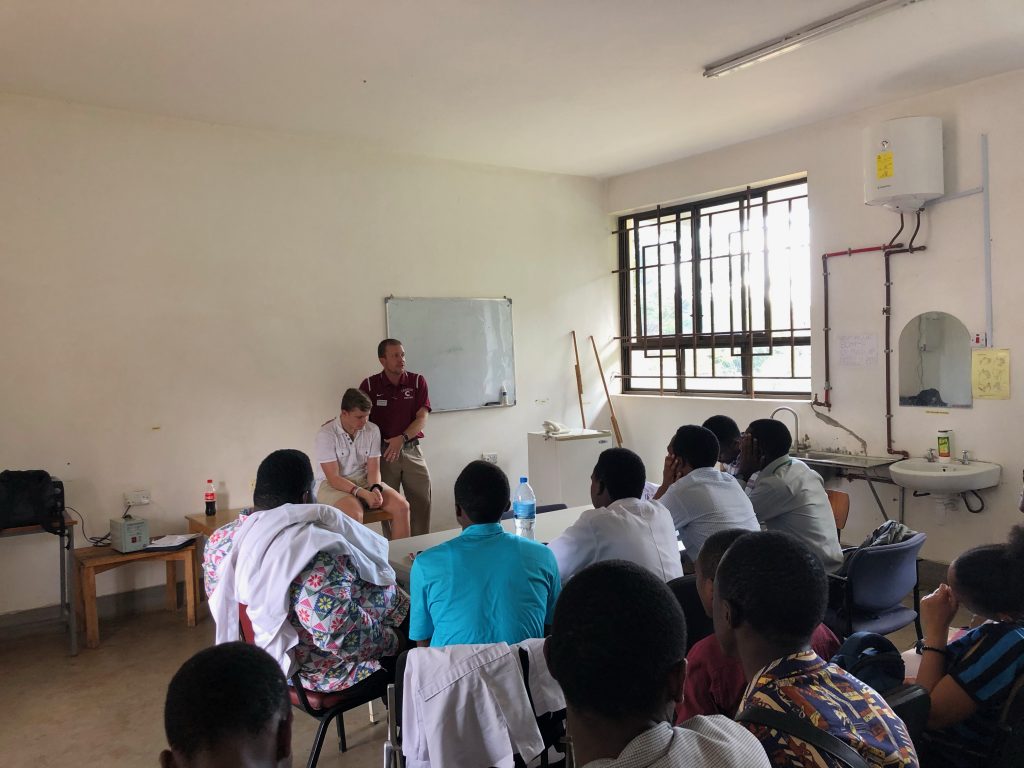It’s Thursday in Tanzania and tomorrow is our last full workday. I’m not ready for reflections, and we will press on with a daily review.
Yesterday was a slow day medically. I’m not sure why, but things never really got clicking. The OR was staffed, the clinic seemed routine, and ward rounds were stuck in neutral. After bouncing from place to place for a bit, I settled into a group on ward rounds. The senior resident on rounds was very enthusiastic about teaching to the students and I largely stayed on the periphery adding tidbits here and there. The “orthopedic ward” is covered by orthopedic residents and interns and there is very little cross coverage from other departments. It is amazing the breadth of problems they try to tackle. The senior resident gave a bedside lecture on cardiomyopathy (heart disease) which is in sharp contrast to my resident days of leaving my stethoscope in its place of honor on a shelf!
Later that day, I lectured on foot and ankle trauma. The residents are very impressive with their book knowledge and I do not doubt they could outdo me in orthopedic trivia. The problem is the application and judgment (which comes from experience). I continue to hammer on some “clinical” points that I think would help drive improved results. The main focus has repeatedly been the importance of restoring basic alignment (primarily length!!) – even with the early provisional procedure that seem elementary, but drive the final result.
Today, I knew my destination (for a change)! A resident had booked a knee scope and showed me the MRI the day before. He specifically asked for me to help out and asked if I was an expert with knee scopes. Expertise is in the eye of the beholder, but I felt I could carry on!
The OR was packed. There were at least 8 residents and many medical students in attendance to observe. With some questioning, it seems they do very few knee scopes. My resident for the day offered that he had assisted with several scopes in the past but it did not sound like he had done the surgery. I told him he was the player and I was simply the coach – time to get in the game. We prepped the patient, setup the instruments, and began. With some help, he made his entry portals and placed the camera. Unfortunately, that is where the story ends…
The camera would not work. We worked and worked with the wires, boxes, and parts, but no luck. The head of the department showed up and tried to get things working, but to no avail.
All surgeries have a plan B (or should). Undaunted, I turned to my visibly disappointed friend and described how our now open arthrotomy of the knee was going to work. We made the approach, examined the knee, found the loose bodies (goal of the case), and closed things up. While it was not the glorious scope, the surgery was successful.
I moved to the adjoining room to help two residents with an open tibia fracture. The leg needed external fixation and – similar to our plating experiences – the scramble for parts began. An external fixator is a relatively simple contraption of pins, bars, and connectors. When the parts are an assortment of various companies’ parts, it becomes a bit more frustrating. We would find the right connector but an incompatible wrench or bar. At last, the construct was complete and the case concluded!
Of note, this was also my first experience with operating in a power outage. Brownouts are relatively frequent here but seem to occur mainly in the evening hours. Today I learned to operate by phone flashlight. Make sure you charge your phone daily!!
The day concluded with a lecture on spine trauma – attendance was significantly higher than yesterday. Many of the medical students who have spent the past two weeks with me had some kind thoughts afterward and definitely make the trials, speed bumps, and uncertainties of the experience more insignificant at the end.
I must close today’s musings with some sad news. The ward admitted a spine trauma patient late last night. He had a significant cervical injury and was quadriplegic. He had spent 4 days at an outside hospital and was transferred in for spine evaluation. He had a C4 level injury and in morning report I expressed surprise at his independent ventilation and emphasized the importance of close monitoring. As the day progressed, the patient began to deteriorate. The ICU was consulted who came promptly and agreed with our team’s assessment. Sadly, the issues of supply and demand are at times too strong. There were no available ventilators, ICU monitors – essentially no way to support life. The patient passed…
Heatlh care at home has its problems. But no matter your politics or leanings in the healthcare debate – just reread that paragraph again. Or, perhaps, reread the entries on this blog from the past two weeks. And then, we all should thank our lucky stars for the amazing access, care, support, and service of our medical teams back home.
Tomorrow concludes these adventures – we will see what it brings.
